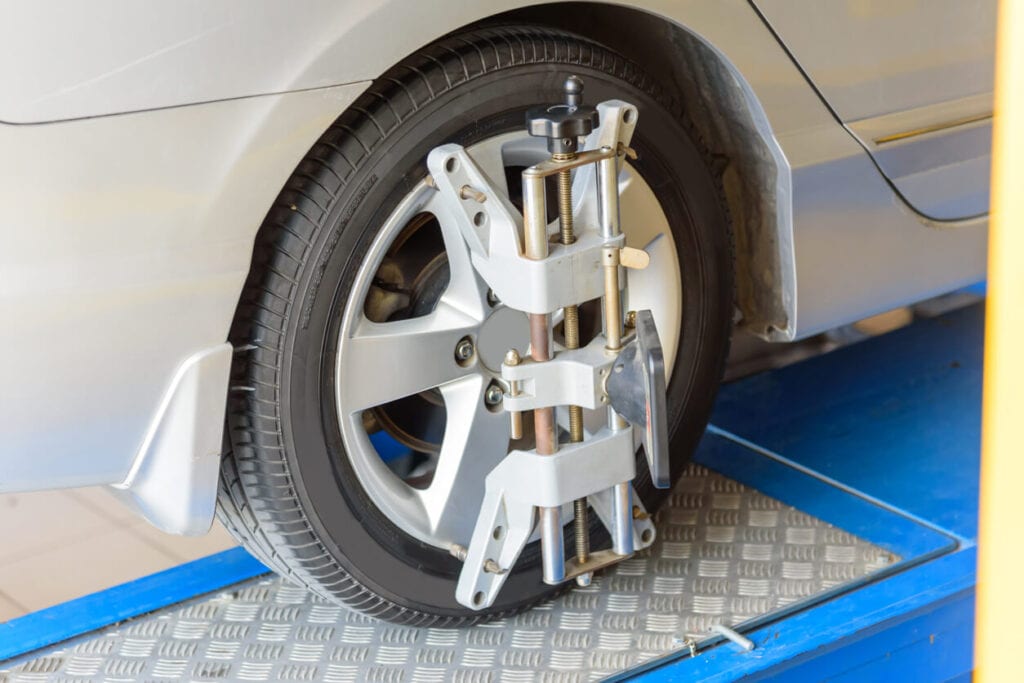Have you ever talked to your vehicle’s auto technician and just nodded your head feigning understanding? You nod along in agreement as automotive terms go in one ear and right out the other. Then, you’re handed a piece of paper with an illustration of a car, some red, green, and yellow colors, and a bunch of numbers that make absolutely no sense.
Deciphering this report on your own could leave you feeling like you’re trying to solve a riddle, but it doesn’t have to be. With our guide you’ll learn how to read a wheel alignment report just like the pros and the next time you’re talking with your technician, you’ll nod along with complete understanding.
What Is A Wheel Alignment?
Alignment is part of the suspension system and is the geometric measurement of how the wheels fall into line and rotate at the same speed and direction. When your vehicle rolls off the assembly line at the manufacturer, engineers have determined and set the vehicle to the appropriate alignment specifications. 
With use, the occasional bump against a curb, or new tires, the vehicle falls out of alignment. Though it doesn’t happen overnight, gradual changes affect the alignment in your vehicle eventually requiring the need for an alignment.
That’s why it’s a good idea to have your alignment checked at least once per year.
The alignment system is measured in three different areas including camber, caster, and toe. An adjustment is needed when either of these angles fall out of their predetermined specifications.
How To Read Wheel Alignment Specifications
Camber
Camber measures the angle that the wheel and tire stand relative to the road. Camber is typically positioned with a slight angle as opposed to completely upright which helps counterbalance forces due to cornering.
- Positive Camber occurs when the wheels lean away from the vehicle at the top. Too much positive camber results in tire wear on the outside of the tire.
- Negative Camber occurs when the wheels lean toward the center of the vehicle at the top. Excessive negative camber will result in wear on the inside of the tire.
Caster
Caster measures the angle from top to bottom of the steering axis related to the suspension components at the wheel. Simply put, caster is what ensures your vehicle drives in a straight line while also providing directional stability to return to that position after completing a turn.
- Positive Caster occurs when the load is ahead or there is pulling on the spindle. Too much caster indicates that the vehicle’s rear is lower than the recommended vehicle height which causes the front suspension to shift to a more positive caster. If one wheel’s caster is more positive than the other, the wheel will force the vehicle to pull in that wheel’s direction.
- Negative Caster makes steering exceedingly sensitive at high speeds and reduces the wheel’s directional returnability once turns are completed.
Toe
Toe measures the direction that the wheels are rolling. It is imperative that a vehicle’s wheels all roll in the same direction at the same time.
- Positive Toe also known as Toe-in occurs when the wheels are turned in.
- Negative Toe also known as Toe-out occurs when the wheels are turned outward. The number of toe is usually only a fraction of a degree. Toe should be adjusted to guarantee all wheels roll parallel together in synchrony. Poor toe alignment, whether positive or negative, reduces steering ability and causes tires to wear prematurely.
Reading Your Wheel Alignment Report
When the alignment process begins, the technician will use an alignment machine to measure the vehicle. The machine then generates a report that indicates the vehicle’s current specifications, what should wheel alignment be for your particular vehicle, and the degree of adjustment to achieve correct alignment for both front and rear wheels.
Here’s how to determine whether your vehicle has too much or too little camber, caster, or toe at a glance:
By Color
Many alignment reports are printed in full color to help the reader identify which angle is too positive or too negative. Just like a stop light, green means go, yellow means caution, and red means stop. So, too, does the alignment report. Red often indicates that the alignment is too negative or positive while green means the measurement is right on target. In some cases the report will print yellow to indicate to the reader that the alignment is approaching the predetermined limit.
By Number
Inside or beside the colors, there are numbers that are measured in degrees to indicate the variances in the angle of measurement. For example, a negative number identifies when there is not enough angle in camber, caster, or toe while a positive number indicates when there is too much angle. Whether positive or negative, both numbers indicate adjustments need to be made in the opposing direction.
Wheel Alignments and Sun Auto Service
Now that you understand how to read an alignment report, schedule your next alignment with Sun Auto service. Our skilled technicians use only the most sophisticated alignment machines to guarantee your vehicle is aligned to the specifications set forth by your vehicle manufacturer–all in about an hour!
Still have questions about alignments and alignment reports? We love questions! Our friendly Service Advisors and Technicians are happy to answer all your questions. Give us a call or stop in today.
